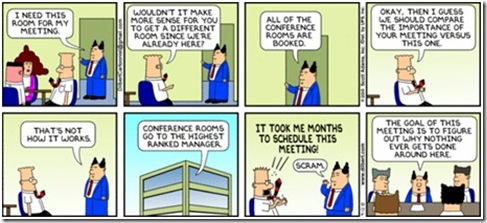Flexible means stripping away fixed alignment and ownership. All resources are flexible. To be pooled and applied to the work load needed. The concept is central to the architecture of Virtualisation technology. But the approach does impose a new requirement for managing the resources and demands on them. Collaboration software like Microsoft Exchange can be a very useful tool to manage this vital resource with the Calendaring function.
In day-to-day office routine one of the most critical and often contentiously shared resources is the ‘Conference Room’. While I maintain that most companies are over-invested in fixed infrastructure like offices, for the office space that they do have, there is one primary and bona fide use for it…getting people together. If it is not about getting people together, then by definition the work content can most likely be done distributed. And the conventional resource for ’getting together’ is the conference room. While the whole notion of a conference room, with its classic big table in the centre a fluorescent-lit four walls, tends to be unimaginative and dated, it remains a vital tool. And one of the first challenges is simply getting one’s hands on one.
But a tool is only as good as its users. Even when properly structured, bad behaviour like the common syndrome that Dilbert illustrates above derails the whole system. When people talk about ‘change management’ starting with executive sponsorship, they don’t mean the top guy sending out a cheerleading memo, but rather the leaders leading the way with role model behaviour. That’s why one of my first recommendations for companies that truly want to promote aggressive adoption of flexible working is for the CEO/MD to be the first person to get rid of their office/desk. And to abide by the Conference Room booking protocols. 72AJWHBNJW56
